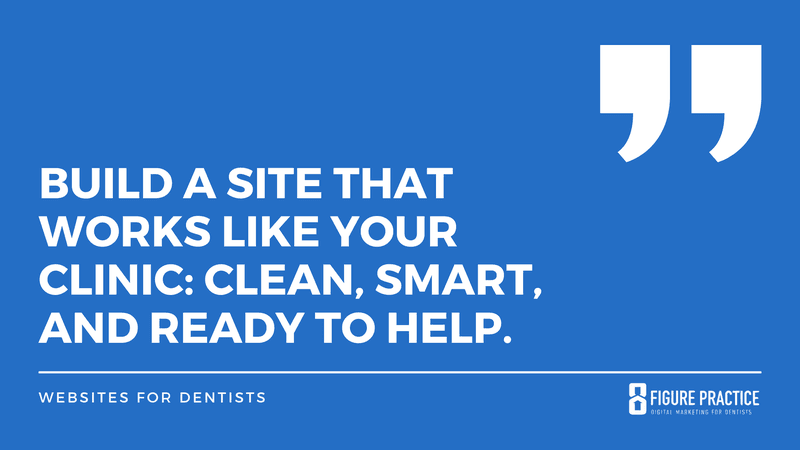
If a website still looks like it did in 2020, it’s already behind. In 2025, a site is often the main reason a patient decides to call or walk through the door. Great design, smart content, and fast booking are no longer extras. They drive growth and raise a practice’s value. This guide explains what today’s best websites for dentists do right—and why waiting to update might cost growth and patients.
Key Takeaways:
- Top websites for dentists in 2025 feature clean layouts, mobile-friendly design, real team images, and instant online booking.
- Clear calls-to-action ("Book Now") and live chat lead to more new-patient conversions.
- Custom video, patient stories, and before/after images help build trust.
- SEO basics: local keywords, fast-loading and secure (HTTPS) pages, Google Maps, and fresh blog updates.
- With more than 70% of traffic on phones, design must include quick load times, readable fonts, and ADA accessibility.
- HIPAA-compliant forms and secure portals matter for privacy—and peace of mind.
- Top platforms: WordPress for flexibility, Wix or Squarespace for simple setups, ProSites and Smile Marketing for dentist-built solutions.
- Strong branding pairs calming colors, real visuals, and a consistent tone to build trust.

What Do the Best Websites for Dentists of 2025 Get Right?
The best dental websites give patients what they’re looking for—and do it fast. The most common theme? Simplicity wins. Smile Dailey Dental’s site, for example, uses gentle colors, white space, and short, clear text to create an inviting feel with no clutter.
The clearest trend is easy booking. Sites like Tend, Peak Dental, and Zen Dental put “Book Now” front and center. Visitors know what to do instantly, which builds trust.
Another standout feature is the use of real team photos instead of stock images. Village Dental and SmileLA showcase their staff smiling, creating a personal and authentic connection that matters.
What are common elements between today’s top-performing dental websites?
Answer: Online booking, real photos, minimal design, bold CTAs, mobile-friendly pages.
Each of these helps visitors act quickly and feel reassured. A clean site signals attention to detail, which can lead someone to choose one office over another.
For more information on what works best on websites for dentists, visit Eight Figure Practice.
Layout and Design
How do layout and design add to a sense of credibility?
Answer: They shape the visitor’s first impression. Calm, clear layouts feel trustworthy.
A crowded or messy interface can raise doubts about care quality. Sites like Dentologie or HelloTend use pale colors, minimal fluff, and simple menus. Every click feels smooth, encouraging visitors to stay longer and feel relaxed.
Content and SEO
What sections help SEO and keep visitors engaged on dental sites?
Answer: Helpful service pages, real patient reviews, and updated articles with relevant keywords.
Austin Oral Surgery and First Hill Dental write content that works—for both Google and people. Local terms like “wisdom tooth removal Austin” are used alongside fresh blog updates that keep rankings high.
But SEO alone doesn’t hold readers—strong pages do. FAQs, before/after images, and visible trust badges demonstrate experience and reliability.
Delmain’s guide and sites like HelloTend show how effective design and content work together.
Conversion Features
What features should every dentist website include for conversions?
A website that doesn’t bring in new appointments is just decoration. Conversion requires smart tools: bold buttons, clear CTAs, and instant booking.
Why are clear calls-to-action and instant booking so helpful?
CTAs like “Book Now” or “Call Us” guide patients directly. Instant booking removes friction. Tend and Austin Oral Surgery keep CTAs consistent across pages, making it easy for visitors to act.
Booking systems like NexHealth allow two-click scheduling, as used by Zen Dental Studio and The Gleamery. Without these tools, many potential patients leave.
How does live communication (chat, forms) support conversions?
Forms and live chat turn questions into bookings. A user hesitant to schedule might simply ask, “What does whitening cost?” Fast responses keep leads warm.
Austin Oral Surgery uses a short front-page form for easy contact. Endodontic Excellence of Reston adds service-specific quizzes to guide visitors into the right care. Live chat works best with real representatives, but clear response expectations also build trust.
What makes patient quotes and photos so effective?
Authenticity builds trust, and trust leads to action. SmileLA features real patients and quotes directly tied to services, while Pearl Dental highlights Google reviews for extra credibility.
Search and Local SEO
How can dental websites be ready for search in 2025?
Key details: clear keywords, consistent listings, fast load times, HTTPS security, and regular content updates.
Local SEO is crucial. Google Maps listings, matching contact info, and patient reviews improve both ranking and reputation.
Fresh content signals relevance to Google. Monthly blogs, FAQs, and short videos add visibility and engagement. Linking blogs on social media multiplies their impact.
Platforms and Tools
What are the best platforms for dentist websites?
WordPress offers flexibility and scalability, while builders like Wix and Squarespace are best for simple setups.
For dentist-specific solutions, ProSites, Sesame Communications, and Smile Marketing provide HIPAA-ready, prebuilt options. WordPress themes like “Dentalia” also serve as customizable foundations.
Mobile and ADA Compliance
With 70%+ of traffic on phones, mobile-first design is essential. Buttons should be thumb-friendly, text easy to read, and menus simple.
ADA compliance ensures accessibility for all patients. Screen-reader compatibility, alt text, and accessible layouts show inclusivity and prevent barriers to care.
Responsive design adapts across devices, ensuring smooth browsing whether on phone, tablet, or desktop. Swish Dental exemplifies a mobile-first, user-friendly experience.
Branding
Branding shapes the patient’s perception before contact is made. Soft, calming colors, clean fonts, and authentic team visuals convey professionalism and warmth.
Short videos, authentic staff photos, and clear value statements (“Gentle care. Same-day service. Honest answers.”) help establish credibility quickly.
Consistency across pages—from homepage to blog—strengthens brand identity.
Costs and Maintenance
Dental websites typically range from $3,000–$10,000 upfront. Templates and simple designs fall at the lower end, while custom, branded builds cost more. Ongoing support runs $100–$300 monthly for updates, backups, and fixes.
Some providers bundle hosting, design, forms, and HIPAA compliance into $150–$500/month plans. Strong hosting ($20–$100/month) ensures speed and security.
Secure Portals and Forms
HIPAA compliance is mandatory when collecting health information. Encrypted portals allow patients to book visits, access x-rays, pay bills, and message staff securely.
Trusted tools like NexHealth or RevenueWell handle encryption and compliance. Short, simple, consent-based forms improve safety and user experience.
Marketing Integration
Websites support marketing by syncing with software tools. Appointment forms, follow-up reminders, and email capture drive retention.
Search visibility improves with strong keywords, reviews, captions, and multimedia content. Sites like Parks Family Dental highlight star reviews directly, reinforcing both SEO and trust.
Niche Styles
Pediatric sites lean on pastel tones, friendly icons, and child-focused content. Orthodontic sites emphasize transformations with before/after visuals and smile preview tools. Implant sites often provide cost calculators, walkthroughs, and 3D visuals.
Specialty pages focus on credibility—clear skills, certifications, expert videos, and detailed guides. Endodontic Excellence demonstrates this with simple but precise messaging.
Strong websites do more than look good—they build trust, secure bookings, and grow long-term value. Clean design, helpful tools, and authentic branding remain the winning formula for dental practices in 2025.
Ready to Grow Your Practice?
Want to bring in more high-value patients, highlight your results, and create a brand that stands out? Eight Figure Practice gives dentists the tools to scale with confidence. From sleek websites and smart SEO to targeted ads and brand strategy, every piece works together to drive growth. Book a strategy session today and see how the right plan turns into measurable success.
